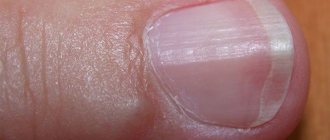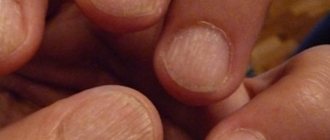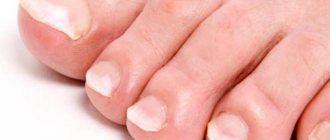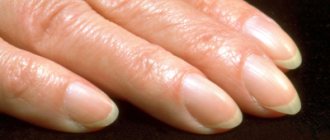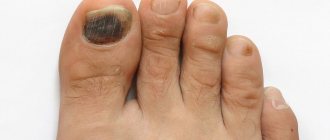Differences between a healthy nail and a diseased one
Deformed nails are much more common on the feet than on the upper limbs. This is due to the higher load on this anatomical area, which occurs daily and for a long time. Typically, changes in the structure and surface of the nail begin on the big toe, then spreading to others. No less often, one can notice curvature, thickening or darkening of the nail on the little finger, which is compressed by uncomfortable shoes.
The deformation of the plates does not always have serious causes, but it never goes unnoticed, representing a significant cosmetic drawback. Here are the main differences between a healthy nail and a diseased one:
| Sign | Normal nail | Affected nail |
| Thickness | About a millimeter | Thinning or thickening |
| Strength | Strong | Fragile, brittle |
| Surface | Smooth, even, slightly convex, shiny | Uneven, dull, rough, may have compactions |
| edge | Smooth, with regular outlines | Uneven |
| Color | Pink | Yellow, brownish, white, bluish and even black |
| Periungual fold | Normal, flesh-colored | Unchanged or inflamed |
In addition to the body of the nail, the nail bed also changes. Normally, there are many capillaries in it, so they shine through and give a pinkish color to the horny part of the nail. With various dermatological diseases, blood circulation may change, so the shade of the nail plate is disturbed. All types of deformities belong to the group of onychodystrophies and require detailed diagnosis. Often their causes are infections, chronic dermatoses and other diseases, so it is necessary to make a diagnosis in time.
Types and manifestations of nail deformation
Symptoms of individual types of nail plate deformity can vary greatly. Depending on the cause, their symptoms are different. Here are the main forms of onychodystrophy with deformation and their clinical manifestations:
- Koilonychia. This is a spoon-shaped deformity that rarely occurs in the legs (more often on the arms). The surface of the nail becomes concave in the center, the thickness and structure do not change at an early stage, after which the nail becomes thinner.
- Onychogryphosis. It is a deformation in the shape of a bird's claw, in which the plate bends and becomes very thick, yellow, black or dirty gray in color.
- Bo's lines, or transverse grooves. The depth of the grooves is up to 1 mm, the color of the grooves is the same as the entire plate. If there are many grooves, then the nail becomes ribbed, corrugated, and wavy.
- Hippocratic nails. The plate becomes convex, spherical. The causes of the condition are serious - oncology, heart disease, tuberculosis.
- Point thimble-shaped deformity. The nails take on the shape of a thimble and are covered with small dots and depressions. The diameter of the recesses is 0.3-1 mm, the depth is up to 1 mm, the number is from 1-2 to tens.
- Flattening of nails (platonychia). Basically, it is observed from birth and affects all toenails or fingernails. The color of the plate is normal, but the plate itself looks flat.
- Trachyonychia. The surface of the nails begins to peel off and becomes rough. It looks dull, dry, and sometimes has pinpoint depressions. The free edge becomes jagged and cracks appear on it.
- Onychorrhexis and onychoschisis. Both diseases mean abnormal splitting of the nail plate, and in the first case it is longitudinal, in the second it is transverse. If the cleft is lamellar, it is often congenital.
- Longitudinal grooves. They usually occur in old age, although they can appear even in a young person. With this pathology, each groove and ridge correspond to protrusions at the bottom of the nail plate. This type of deformity can exist in the form of longitudinal canal-shaped dystrophy, which covers only the thumbs. A wide channel (groove) of great depth appears in the center of the nail.
- Ingrown nail (pincer nail). When a nail grows incorrectly, the edge grows into the nail fold. The plate takes on a pincer-like shape. The soft tissues become inflamed and covered with bloody crusts. Pus is constantly released, and sometimes there is a very unpleasant odor from the feet. Because of the pain, a person begins to limp, suffer from cutting and burning.
- Onycholysis. This is a partial detachment of the nail, the plate is separated from the bed. It starts from the free edge, which initially turns white. The process proceeds quickly and is more often recorded on the big toes.
- Jadasson-Lewandowski syndrome, or pachyonychia. The nail plates sharply thicken and become gray or brown. This deformity mainly occurs in men.
Also, with many forms of deformation, white spots are present - leukonychia. With most forms, brittleness, delamination of nails, and peeling of the top layer occur.
Why is onychomycosis dangerous?
neglected fungus
Itching, burning sensation and discomfort with fungal skin infections are caused by contact of the epidermis with mycotoxins. These substances, foreign to the human body, have toxic properties, cause inflammation and disrupt metabolism in skin cells.
When the nail plates are affected, such symptoms are less pronounced. Unpleasant itching sensations occur only in advanced cases , when the fungus “gets” to the tissues under the nail plate. The fungus lives in the nail and multiplies, releasing poison into the surrounding tissue. The body suffers from poisoning, only toxins enter it in smaller quantities than with dermatomycosis.
Advanced onychomycosis is accompanied by cracking and damage to the skin around the nail - this is the entry point for other infections. The appearance of wounds and suppuration is possible, infection with Pseudomonas aeruginosa and Staphylococcus aureus is possible. Long-term coexistence with the fungus ends in onycholysis - complete destruction of the nails. New plates do not grow back, leaving the surface of the fingers unprotected. The tissues under the nails are not adapted to friction, pressure, or contact with the environment. A person without toenails experiences pain. Wearing shoes becomes torture. Self-doubt and complexes appear.
Onychomycosis is more difficult to cure than fungal skin diseases. The nail plate is denser, and its base is located inside the dermis. The fungus is capable of spreading its spores there, which are difficult to eliminate, even with the help of powerful medications.
Causes of pathology
There are many prerequisites for the development of deformities of the nail plates of the feet, and they are not always local. Sometimes the problem lies in damage to the internal organs, and then the nail disease is part of the general symptom complex.
Fungal diseases
The fungus causes deformation of nails in 50% of cases. Medically it is called onychomycosis and can exist in the following forms:
- white superficial;
- distal subungual;
- proximal subungual;
- dystrophic total.
Onychomycosis leads to a change in the appearance and color of the plate; spots, grooves, and various growths appear on it; at an advanced stage, it exfoliates and crumbles. The disease is accompanied by itching, unpleasant odor, burning, and sweating. The cause of infection is wearing or trying on someone else's shoes, poor hygiene, direct infection in a public place (bathhouse, sauna). The fungus tends to quickly spread to healthy toes.
Injuries
Trauma is a common cause of changes in the shape of one or more nails. Pathology is caused by bruises, fractures of the first phalanx of the finger, pinching, separation, various injuries during a pedicure, and surgery to remove felon. Damage to the periungual bed or fold can also cause problems. Complete detachment of the nail due to injury is especially dangerous; sometimes it requires surgical intervention.
Diseases of internal organs
In this case, the damage to the nails is persistent and covers not one, but several nails on both feet. Problems are associated with a malfunction of the internal organs and can be expressed by the following changes in the plate:
- redness – cardiac pathologies;
- yellowing – pulmonary diseases;
- yellow-blue spots – diabetes mellitus;
- paleness, whitening – liver problems;
- excessive pinkness – kidney dysfunction.
Psoriasis
Psoriasis is a chronic disease in which there is no infectious process, but the skin becomes covered with plaques, and the nails split and become yellow. The adjacent skin cracks, the wounds hurt, and blood oozes from them. In severe cases, the deformation is combined with thickening and suppuration, and the appearance of a pattern in the form of stripes on the plates. The causes of the disease have not been precisely established; most often it is hereditary.
Onychotillomania
Persons with a rare mental disorder – onychotillomania – independently damage their nails. Unlike those who have the bad habit of biting their nails, such patients constantly tear off and remove plates in different ways. The person is convinced that they contain microbes or that the nails can harm him in some other way. Treatment of this disease is carried out only under the supervision of a psychiatrist.
Other reasons
Eczema, like psoriasis, is an autoimmune pathology, but has less severe consequences. This disease affects only the skin, often located on the legs - on the back of the foot, on the toes. Due to constant itching and rubbing of the skin, the periungual ridges become inflamed. Gradually, the chronic process leads to damage and deformation of the plate. Similar consequences can be caused by a disease such as lichen planus.
Congenital types of deformities are associated with anomalies and defects of the ectoderm that are formed during the period of intrauterine development of the fetus. Around the end of 3 months, the nail bed, ridges, and skin begin to emerge, and by 7-8 months, marigolds appear. If teratogenic factors acted on the body of the mother and fetus during these periods, there is a risk of disruption of the nail matrix and its deformation.
Also, changes in the structure and shape of the nail plates can occur for the following reasons:
- regular contact with aggressive detergents, fertilizers, chemicals, solvents;
- abuse of extensions, varnish, gel coatings;
- working with formaldehyde (for example, manicurists);
- carrying out chemotherapy, radiation;
- oncology;
- wearing constrictive, rough, inappropriate shoes.
Nails can change due to a deficiency of vitamins and minerals, especially vitamin D, B1, calcium, and iron. They often become deformed due to anemia and low protein intake in those on a strict diet.
Main causes of deformation
Sometimes a person neglects the rules of nail care, considering it a secondary matter, but just as you take care of the cleanliness of your body, you should also take care of the cleanliness of your toenails and fingernails. If this is not done, various infections can penetrate under the nails. In addition, healthy and well-groomed toes will add special attractiveness in the summer.
Nail plates are a kind of indicators of diseases: by their appearance, you can recognize the initial stages of some diseases, for example, infections, which can be detected at an early stage and eliminated in a timely manner.
If there are any problems in the body, the color of the nails first changes. You should pay attention to the following signs:
- If the nail plate has acquired a reddish tint, especially its bed, then it is better to visit a cardiologist - you may have problems with cardiac activity.
- A yellowish tint indicates problems with the lungs.
- If the nail bed is too pale, you may develop anemia.
- Yellow plates with a blue tint are found in patients with diabetes.
- If white spots appear, check your liver.
- Half pink and half white indicates kidney dysfunction.
Nails can become deformed for various reasons:
- If there are diseases of the internal organs.
- For injuries and mechanical damage.
- The reason is the development of anemia.
- The effects of antibiotic therapy or chemotherapy, in the absence of further treatment to remove the remaining drugs from the body.
- Dystrophy of the nail plates, inherited.
- Presence of fungus.
- Infections of bacterial origin.
- Skin disease, such as psoriasis.
- Wearing uncomfortable shoes.
The changed shape of toenails can be different; each type should be considered separately:
- Grooves resembling a wave over the entire surface (nails have become wavy) - wavy nails occur due to an unbalanced diet or psychological trauma. Sometimes hereditary predisposition plays a role. If you experience this condition and do not know the cause, consult your doctor.
- Concave nails that look like a depression or hole - this indicates a lack of calcium in the body, which must be replenished with nutrition.
- Transverse stripes along the entire nail plate are formed due to trophic disorders, for example, after prolonged use of antibiotics or a long-term lack of adequate nutrition.
- Splitting, ribbed nails - if the nails are crumbling, this may be due to anemia, lack of calcium, vitamin B1, or a thyroid disorder.
- Deformation of the nail due to injury or uncomfortable shoes, the nail looks like a lump - this disease has a specific name in medicine.
- Onychogryphosis. At the same time, the nail thickens, bends and brings a lot of discomfort. The basis of treatment for this disease is the action of reducing the thickness of the nail plate, sometimes requiring complete removal of the nail.
- Ptergia or cuticle hypertrophy - this phenomenon is characterized by rapid growth of the cuticle. Sometimes the cuticle covers the entire nail. At home, it is soaked and then carefully cut off.
- Thickening and yellowing of the nail due to exposure to a fungal infection - this condition is accompanied by discomfort and pain; if treatment is not carried out, the fungus will spread to other parts of the body. Remember that bacteria prefer wet socks and shoes. It is easy to catch fungus in public swimming pools, bathhouses, etc.
Thus, it was found out why nails grow incorrectly, now it is worth finding out the measures to treat this deficiency.
Diagnosis of the problem
To make a diagnosis and select treatment methods, you need to contact a dermatologist or specialized specialists - podologist, mycologist. To exclude or confirm a fungal disease, a scraping is performed from the affected plates, followed by a microscopic analysis. The doctor also examines the nails under a lighted magnifying glass, studying in detail the shape, color, structure, and type of edges.
To clarify the diagnosis, the following examinations may be required:
- blood test for microelements;
- spectral analysis of the nail plate;
- general blood analysis;
- blood biochemistry;
- consultations with a gastroenterologist, pulmonologist, cardiologist, surgeon – as necessary.
Treatment methods
The pathology should be treated depending on the diagnosis. If the deformity is caused by internal diseases, the problem cannot be eliminated without an effective course of treatment. Even removing the nail plate will not work - the new nail will grow crooked. Therefore, treatment begins with the elimination of the underlying disease, and correction of the deformity will occur over time.
The main methods of therapy are as follows:
- For fungal nail disease - antimycotic tablets, application of ointments, varnishes with fungicidal components.
- For ingrown toenails – laser or surgical removal of the plate, cauterization of wounds and defects. A non-surgical method of treatment is possible - the application of plates, half-braces, staples.
- During the inflammatory process - applying ointments, treating with antiseptic solutions, carrying out physiotherapeutic procedures - UHF, amplipulse therapy.
- In case of circulatory disorders, take angioprotective drugs, venotonics, and means to improve blood microcirculation.
For any pathology, you should eat right, take vitamin complexes with selenium, zinc, calcium, phosphorus, and iron. There are also folk methods of treatment - with the help of herbs and other improvised means, they are used for mycosis of the nail plate (course - up to a month):
- Squeeze fresh celandine juice. Lubricate your nails, repeat three times a day.
- Regularly smear your nails with aloe juice, Kalanchoe or eucalyptus oil.
- Pour warm water into the bath, add 3 drops of iodine and the same amount of tea tree oil. Place your feet and stand for 10 minutes. Repeat daily.
Treatment with herbal infusions
Herbal infusions are useful not only if the cause of nail deformation is infection, they can soothe irritation and also soften the nail plate, which can be easily cut off if necessary. Infusions with celandine are very useful. To do this, take a glass of water per tablespoon of raw material. Pour boiling water over the herb and place in a steam bath. After 15 minutes, the liquid is left to cool, but only so that direct sunlight does not fall on it.
After this, apply lotions to the sore nail for 15-30 minutes. Use this remedy every day for 3 weeks, then you can take a month break.
Restoring nails after deformation
A nutritious diet, which contains enough protein, vitamins and minerals, promotes faster growth of a new, healthy plate. It is important to always monitor foot hygiene, wear only clean socks or tights, and avoid hyperhidrosis (use powders, talc, baths). It is useful to regularly use scrubs that restore oils. Other patient advice:
- temporarily give up salon pedicures, coatings, and plate polishing;
- do not use varnishes, except for medicinal ones;
- purchase high-quality shoes that fit perfectly;
- Do not wash your feet with harsh chemicals.
Unevenness correction
Before rushing to see a doctor with the problem of wavy nails, you should rule out factors not related to illness. To do this, you need to strictly follow the following rules for several weeks:
- lead a healthy lifestyle. Stop smoking and drinking alcohol, fill your diet with healthy dishes and normalize your work and rest schedules.
- Maintain hand and foot hygiene. Many people mean by this regular washing and applying creams. You should also add to this list the wearing of individual slippers, towels and linen in common areas, such as a swimming pool and sauna, as well as the use of only your own personal manicure tools. By the way, they must be regularly disinfected.
- pay special attention to care. During this period, it is advisable to refuse to cover your nails with decorative varnishes, and ask for strengthening and healing procedures at the manicure salon. You can organize them at home by finding useful tips on the Internet. Hardware polishing and the use of rough tools when processing nails should be avoided.
- choose shoes by size. You should take care of your toenails by choosing comfortable shoes that do not put pressure on your feet and toes.
- get used to the gloves. It is advisable to carry out all household chores with rubber or cotton gloves. Everyone knows about this, but some claim that it is inconvenient for them to clean. However, if uneven nails indicate some problems with them, it is better to adopt this useful habit. The same applies to professions in which workers are recommended to wear protective gloves. Do not neglect this advice.
If, despite following all the above rules, symptoms persist, you should consult a doctor.
Prevention
To prevent deformation, preventive measures must be taken. It is important to avoid injuries, any mechanical damage to the nails, and perform a pedicure using sterile instruments. Feet should be washed with high-quality products, while wearing only appropriately sized, soft and durable shoes. You should not wear someone else's shoes to avoid the risk of fungal infection. If you suspect a serious disease - eczema, psoriasis and others - it is important to immediately seek help from a specialist.
